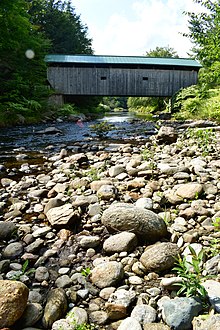Morgan Covered Bridge | |
|---|---|
 Bridge in U.S. state of Vermont | |
| Coordinates | 44°44′35″N72°43′41″W / 44.743°N 72.728°W |
| Carries | Automobile |
| Crosses | North Branch of Lamoille River |
| Locale | Belvidere, Vermont |
| Maintained by | Town of Belvidere |
| ID number | VT-08-07 |
| Characteristics | |
| Design | Covered, Queenpost |
| Material | Wood |
| Total length | 70 ft 11 in (21.62 m) |
| Width | 12 ft 2.75 in (3.73 m) |
| No. of spans | 1 |
| Load limit | 5 tons |
| Clearance above | 8 ft 6 in (2.59 m) |
| History | |
| Constructed by | Lewis Robinson, et al. |
| Construction end | 1887 |
| Coordinates | 44°44′36″N72°43′40″W / 44.74333°N 72.72778°W |
| Area | 1 acre (0.40 ha) |
| NRHP reference No. | 74000229 [1] |
| Added to NRHP | November 19, 1974 |
The Morgan Covered Bridge, also known as the Upper Covered Bridge [2] is a wooden covered bridge that crosses the North Branch Lamoille River in Belvidere, Vermont on Morgan Bridge Road. Built about 1887, it is one of the two covered bridges in Belvidere, and one of five in a five-mile span that all cross the same river. It was listed on the National Register of Historic Places in 1974. [1]



